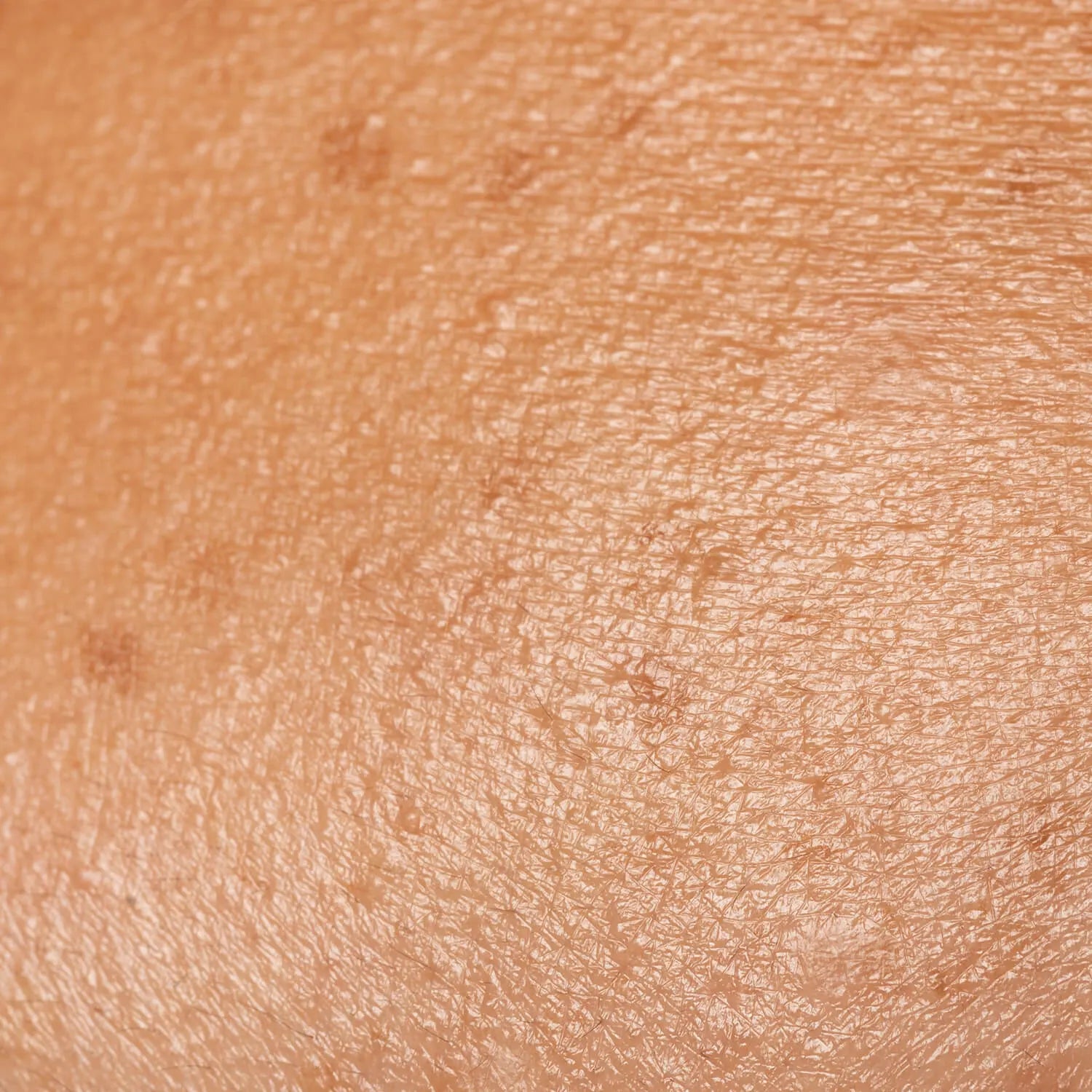
Treating and preventing pigment spots
What are pigment spots?
Pigment spots, hyperpigmentation, and especially dark age spots are considered unattractive, even though they generally do not pose a health risk. Brown spots make the skin appear unbalanced and noticeably older. Hyperpigmentation on the face, such as age spots or acne scars, can be covered with makeup, but there are also ways to permanently fade pigment spots. While dermatological treatments promise quick and lasting results, they come with undesirable side effects. Alternatively, there are many recommended home remedies, although unfortunately mostly ineffective. A much better option is the use of very skin-friendly natural cosmetic ingredients, which slowly fade pigment spots without side effects.
Common types of pigment spots
There are four common forms of hyperpigmentation:
-
Sun spots or age spots
usually occur after the age of 40. These small pigment shifts occur primarily in the areas of the body most exposed to sunlight: the face, neck, forearms, and hands. -
Melasma
have ragged edges and tend to be larger than other pigment spots. They are usually caused by hormonal factors such as an excess of the female sex hormones estrogen and progesterone, for example, during pregnancy. Melasma also occurs on areas of skin that are frequently exposed to the sun. -
Post-inflammatory discoloration
Spots like pimples typically appear after inflammatory skin conditions like acne or after skin injuries. Once the wound has healed, a darkly pigmented area of skin may remain due to an overproduction of melanin. -
freckles
Freckles are small, reddish- to golden-brown pigment spots on the face, arms, and shoulders that appear especially in summer in very fair-skinned people of the Celtic skin type with particularly light-sensitive skin. In the sun-drained months, freckles fade again.
Are pigment spots dangerous?
In principle, pigment spots are harmless. Freckles are even considered attractive and enhance a natural appearance. Other hyperpigmentations, such as sun spots or age spots, are considered disturbing, even though they don't require medical removal.
In exceptional cases, if a pigment spot has an asymmetrical shape, a tapered border, dark and light shades, or temporarily enlarges or changes color, this may be a sign of malignant melanoma or skin cancer. In such a case, you should have the hyperpigmentation examined by a dermatologist.
How do pigment spots develop?
The pigment melanin, produced by melanocyte cells, is responsible for the skin's natural brown color as a protection against sunlight. Melanin serves as a shield for the skin against cell damage. Dark pigment spots develop when the melanocytes of the epidermis, the uppermost layers of the skin, produce excessive amounts of melanin, leading to localized accumulations of the pigment.
What causes pigment spots?
Pigment spots can have many causes. These are the most important:
-
UV radiation
The development of pigment spots is mainly related to excessive UV radiation from extensive sunbathing and a lack of sun protection. -
Waste products due to oxidative stress
Pigmentation disorders caused by sun or age spots are also a result of oxidation processes in the skin. When the unsaturated fatty acids in cell membranes are damaged by oxidative stress, waste products, such as accumulations of the pigment lipofuscin, are formed. These become visible as dark spots. -
Genetic and hormonal factors
A hereditary predisposition favors the development of pigment spots. Hyperpigmentation is more common in women than in men. Pigmentation disorders are further exacerbated by long-term use of hormonal contraceptives. -
Diseases and medications
Diseases such as an overactive or underactive thyroid or diabetes mellitus can also lead to hyperpigmentation. Some antibiotics or chemotherapy drugs also increase the skin's sensitivity to light.
Lighten pigment spots with natural active ingredients
Natural active ingredients such as vitamin C, bakuchiol, and niacinamide are skin-friendly and proven effective against pigmentation spots and uneven skin tone. These natural ingredients don't remove age spots immediately, but they do fade them, so hyperpigmentation gradually becomes less visible.
Vitamin C
Vitamin C ensures that already stored melanin is removed more quickly from darkened skin cells. Vitamin C also has the ability to inhibit the development of new hyperpigmentation and even out the skin's appearance. With its antioxidant effect, vitamin C prevents environmentally induced cell damage caused by free radicals. Vitamin C also improves the skin's natural protection against UV radiation when combined with sunscreen. The myrto Vitamin C Complex Serum is therefore the ideal complement to the Sunshine Day Oil and should become a permanent part of your skincare routine if you're struggling with dark spots.
Niacinamide
Vitamin B3, or niacinamide, not only combats blemishes and pimples, but also inhibits melanin production in pigment cells, lightening dark discolorations. Our Niacinamide Complex Serum contains 11% niacinamide, making it highly effective against hyperpigmentation such as age spots or dark acne scars.
At myrto you will find the Niacinamide Complex Serum – niacinamide with 12% – a booster against rosacea, acne and pigment spots.
Bakuchiol
Bakuchiol is the natural and skin-friendly alternative to synthetic retinol, which is known for its potentially irritating side effects. Bakuchiol stimulates cell division, allowing the upper layers of the skin to renew faster and significantly fading pigmentation or age spots. The myrto Bakuchiol Serum contains a pure active ingredient of 1% bakuchiol. How can you prevent pigment spots?
Can you remove pigment spots with home remedies?
Home remedies like lemon juice, apple cider vinegar, baking soda, or raw potatoes are said to help with dark spots and uneven skin tone. What's the truth?
-
lemon juice
The pH value of a fresh lemon is approximately 2.4. Regularly applying pure lemon juice to the skin will therefore cause skin irritation. Lemon juice is also phototoxic, causing new pigment spots to appear when exposed to the sun. -
Apple cider vinegar
The same applies to the supposedly lightening acid in apple cider vinegar. Its pH is very low at 2-3, so apple cider vinegar also irritates the skin and inhibits wound healing. -
baking powder
It is recommended to mix baking soda with water and apply it directly to the skin. Baking soda has a strongly alkaline pH of 9-10. Our skin, on the other hand, has a slightly acidic pH of 5.0 to 5.5. Baking soda thus destroys the skin's natural acid protection, leading to irritation and itching. -
Raw potatoes
They contain vitamin C and vitamin B3, which actually work against dark spots. Raw potatoes also don't damage the skin barrier. However, the concentration of active ingredients is too low to produce a visible effect.
Have pigment disorders removed dermatologically
There are various dermatological treatments for the medical removal of pigment spots and skin discoloration, but they all have unpleasant side effects.
-
Laser therapy
In dermatological laser treatments, pigment accumulations are destroyed by laser light-based energy. -
Microneedling
During professional needling, a derma pen with numerous small needles is placed on the hyperpigmented skin areas and repeatedly inserted into the tissue. The micro-injuries are intended to reduce unsightly pigment spots on the skin and stimulate collagen production. -
Microdermabrasion
In this treatment, the top layer of skin is sanded off with a special polishing device made of the finest crystals to stimulate skin renewal, smooth the skin and reduce pigmentation disorders. -
Cryotherapy
In this method, the hyperpigmentation is frozen with liquid nitrogen. The extreme cold causes the hyperpigmented cells to die. The cold shock is intended to stimulate the formation of new collagen tissue. -
Peelings against pigment spots
In this dermatological treatment, chemical substances, concentrated fruit acids, or trichloroacetic acid are applied to pigmented areas of the skin. This causes the upper layers of skin to peel off. This is intended to stimulate the formation of new skin cells.
Disadvantages of dermatological procedures
-
Skin irritations
After dermatological treatments, long-term increased photosensitivity occurs, as well as increased skin irritation, redness, swelling, or even scarring. After laser therapy, for example, the skin should not be exposed to the sun for at least four months – except with a sunscreen factor of 50. Even after many months or even years, extensively treated skin is rarely able to regain its former balance and rebuild a strong skin barrier. Skin damaged in this way is even more susceptible to the development of new pigment spots. -
Vitamin D deficiency
After dermatological treatments, a permanently very high sun protection factor is necessary. This promotes vitamin D deficiency, as it completely prevents the body's own production of vitamin D. This leads to a vitamin D deficiency, which manifests itself in constant tiredness, exhaustion, and fatigue. A vitamin D deficiency can also be responsible for increased susceptibility to infections, depression, or hair loss.
How can you prevent pigment spots?
Consistent sun protection
To prevent dark spots, consistent sun protection is essential. You should generally avoid the midday sun between 11 a.m. and 3 p.m. in the summer. Extensive sunbathing is also not advisable if you want to prevent UV-related skin damage such as dark spots. Protect your face, neck, and décolleté with a sun hat, and protect your eyes with high-quality sunglasses. Cover your most vulnerable body areas with clothing made of natural fibers for effective sun protection.
Care combinations
Skincare combinations work even better than individual products. But don't start with the highest active ingredient concentration. Introduce one product at a time into your skincare routine—not all at once! One example is the combination of niacinamide and vitamin C serum, applied one after the other as a duo. While vitamin C primarily protects against harmful environmental influences as an antioxidant, niacinamide is also effective for blemished skin.
Patience with deeper pigment spots
To effectively combat deeper pigment spots with natural active ingredients, you'll need a lot of patience. The deeper the dark skin pigment melanin is deposited, the longer it takes for the discoloration to visibly lighten. For deep-seated melanin deposits, this can take several months, sometimes even years.
Antioxidants from within
You can prevent pigment spots not only from the outside, but also from the inside by including plenty of vitamin-rich fruits, raw vegetables and nuts in your diet, preferably seasonal and organic.
Conclusion
As you can see, nature offers a whole range of powerful active ingredients for your skincare routine, which can be used to gently remove pigment spots and effectively reduce facial discoloration. This creates the best conditions for an even, uniform complexion in the long term.







